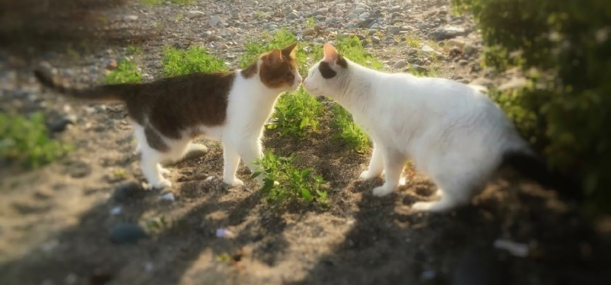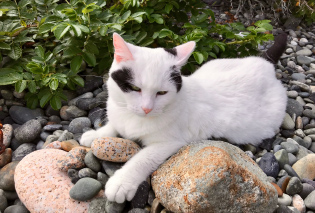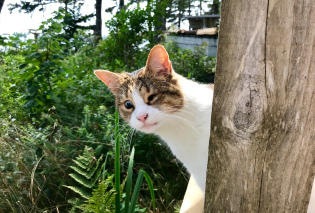Encouraging Positive
Feline Behaviors
Most companion cats are indoor cats. And while technically domesticated, cats are still able to survive on their own. The outdoors represent excitement, problem solving, food acquisition, a smorgasbord of sights, smells, and activities. We make a bargain with cats: we protect them from worldly dangers and in exchange we take away their need to hunt, mate, and to really do much of anything. And we wonder why some of them act out! If we want to be truly responsible for them, then we need to complete that bargain and give them as much enrichment as possible to lead engaged lives.

Negative behaviors like destructive tendencies (scratching), inappropriate elimination, aggression (towards people or cats), hyperactivity (including late night/early morning), excessive vocalization, compulsive behaviors, or play aggression almost always trace back to boredom, stress, lack of environmental enrichment, insufficient territory, anxiety, or some combination of the above. Outdoor cats may have their own challenges, but with the exception of territorial/sexual aggression in intact cats, they don’t exhibit essentially any of the negative behaviors listed above.
Does this mean that we are responsible for the negative behaviors seen in cats? In a word, yes! But, a more nuanced answer goes back to that bargain we made with them, and fully fulfilling our feline responsibilities. The good news is we can have our cats and pet them too! In other words we can protect them and give them happy, fulfilled lives. How do we achieve satisfaction for our living room lions? Bring the forests and the fields inside.
While spaying and neutering removes the need to mate (and the frustration of not being able to), cats still instinctively need both horizontal and vertical territory (climbing trees).
Outside cats will do their business by urinating and defecating in different places. It’s a survival tactic to make it harder for predators to track them, and it’s a “keep out” sign that says, “I was here, just hours ago, stay away!” a form of spatial and temporal marking. This is why the rule exists of one litter box per cat plus one. It’s a way of providing what cats have in nature, choice and agency, a hugely important concept that often gets lost in the sometimes top-down human-cat relationship. The type of box is important too. You can’t give your cat a box that’s too big, so give them the biggest ones you can. Cats are vulnerable when they go, so some need to see out to know they’re safe and for these cats a covered box may be intimidating.



Cats need to hunt, and for indoor cats, hunting means play followed by food. We play with our cat, but we often don’t pair it with a snack or a meal, and this can cause our cat to become bored or frustrated with play and we complain that “My cat doesn’t like to play much.” You probably wouldn’t like your job very much either if you didn’t get a paycheck and for cats, food is the paycheck for hunting and play. Hunting involves problem-solving so make your cat solve problems to get the reward in the form of puzzle feeders, hiding snacks or moving their feeding (and watering) stations around. Create interest and motivation! There is a great article in Companion Animal Psychology (November 7, 2018 – “How To Feed Your Cat: The Modern Guide To Feline Foraging”) that summarizes the American Association of Feline Practitioners consensus statement on how we should be feeding our cats. Outdoor cats eat six to fifteen times daily, and if you only feed your cat canned food twice a day (while maybe leaving “boring” dry food out) you may have a cat that wakes you in the wee hours of the night. Harness the cycle of predation (hunt/play/kill/eat=sleep) by motivating them to conserve calories by playing with them about an hour before your bedtime followed by a nice meal.
Cats need to scratch. It sharpens their claws, stretches tendons, and muscles, and lets them mark using scent glands in their paws. Some like vertical surfaces, others horizontal or angled surfaces, and some prefer different textures. So, find what they like, play with them at this scratching surface and reward them with treats teaching them cause and effect. Maximize this good behavior with “intermittent reinforcement” sometimes rewarding and sometimes not rewarding using what I call the “slot machine effect”.
Clicker training also provides problem-solving, and scents, visual aids (catnip, cat grass, bird videos and window perches) all add spice and variety to your cat’s life. As I like to say, happy cat, happy life!
Footnote: A note about the photos: No cats were harmed in the making of this essay! Happy-go-lucky Cricket (white with black) and her bestie, blind-from-birth Jenny (brown tabby and white) are highly and strictly supervised when outside. For people who want to 100% cat proof a fenced enclosure (yard or deck), these two products, Oscillot and Cat Fence In do an amazing job, something to which Cricket and Jenny cat attest.







